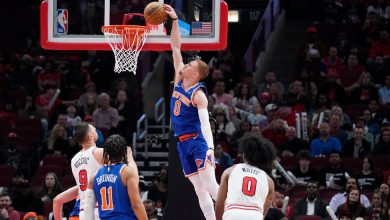Twenty Years Ago, a Tennis Comeback in Australia Like No Other

The day that Jennifer Capriati played the match of her career was sweltering.
It was late January 2002, and Capriati, then 25, was facing Martina Hingis, 21, in the women’s final of the Australian Open in Melbourne. The conditions were so oppressive — on-court temperatures reached 115 Fahrenheit (46 Celsius) — that both players slumped against stadium backdrops between points, even after bathing in ice during a 10-minute break between the second and third sets. They even took turns plopping their worn-out bodies down in a lineswoman’s chair.
It’s been 20 years since Capriati came back from a set and 4-0 down to defeat Hingis 4-6, 7-6 (9-7), 6-2 and claim the third and final major of her career. In doing so, she became the first woman in Grand Slam history to save four match points and win the title.
“The way they both were hitting in that match was just amazing,” said Harold Solomon, Capriati’s coach from 1999 to 2000. “Jennifer was an amazing ball striker because she took the ball so early and she wasn’t afraid, even when she was down. She was as good an athlete as anyone who has ever been in the game, and that includes the Williams sisters.”
The match would go down as one of the greatest comebacks in women’s Grand Slam tennis history. No woman since has saved four match points to win a major final.
Capriati had her professional debut in March 1990, just before her 14th birthday and reached the semifinals of the French Open that year and the round of 16 at Wimbledon and the United States Open. By the end of the season she had won her first WTA tournament and was ranked within the world’s top 10.
Hingis was also a child prodigy. She reached her first U.S. Open semifinal in 1996 when she was 15 years old. The following year she advanced to the finals of all four majors, winning Wimbledon and the Australian and U.S. Opens.
In 1992, Capriati beat Steffi Graf to win gold at the Barcelona Olympics. But a series of events in 1993 and ’94, including a shoplifting charge, an arrest for marijuana possession and a stint in drug rehab, nearly derailed her career.
But Capriati fought her way back, and in 2001 she won the Australian Open by beating Hingis, the world No. 1. Capriati followed that up with a win over Kim Clijsters in the final of the French Open and semifinal finishes at Wimbledon and the U.S. Open. In October 2001, Capriati became No. 1 in the world.
“Determination and will were always strong suits for Jennifer,” said Denise Capriati, Jennifer’s mother, by phone from her Florida home. “She always knew how to fight.”
But no match was as striking as the 2002 Australian final. Hingis raced to a 6-4, 4-0 lead and held a point for 5-0. She did so by using Capriati’s blistering pace to hit short angles followed by forays to the net and soft touch volley winners.
But Hingis double-faulted on a key point and Capriati took advantage. She saved one match point with a backhand down-the-line winner and another after a 14-stroke rally. Two more match points went by the wayside in the tiebreaker prompting Hingis to toss her racket in disgust before both players left the court for the cool of the locker room.
“At that point, we knew Jennifer had the match,” said her mother, who was seated in the players’ box. “She was better in the heat.”
Hingis had leg cramps and was treated after the fifth game of the third set. In the next game she served three inexplicable foot faults and handed the crucial break to Capriati.
“I really don’t know how I managed to win,” Capriati said at the time. “I got my second wind, third wind, fourth wind, I don’t know how many winds out there.”
For Hingis, who reached the Australian final six straight years, winning the title from 1997 to ’99, the loss was devastating. “It was a tough final for her to lose, and it’s difficult for her to talk about/want to reflect,” Natasha Marks, her representative, said in a text message. Hingis declined to be interviewed for this article.
Capriati did not respond to repeated phone and text messages.
After the hype early in her career, Capriati engineered her own free fall and then her own resurgence. The 2002 Australian Open was the culmination.
“She wanted it so bad,” Denise said. “She had fought so hard and done so many things. She was so disciplined to come back. She was doing it just for herself.”



